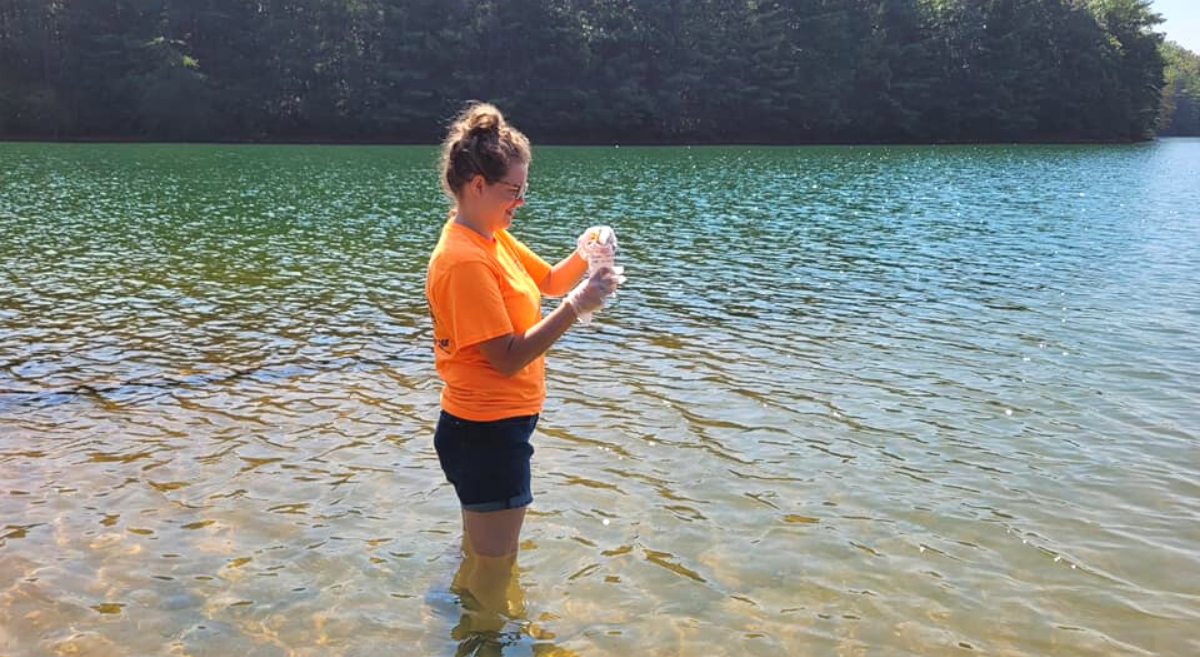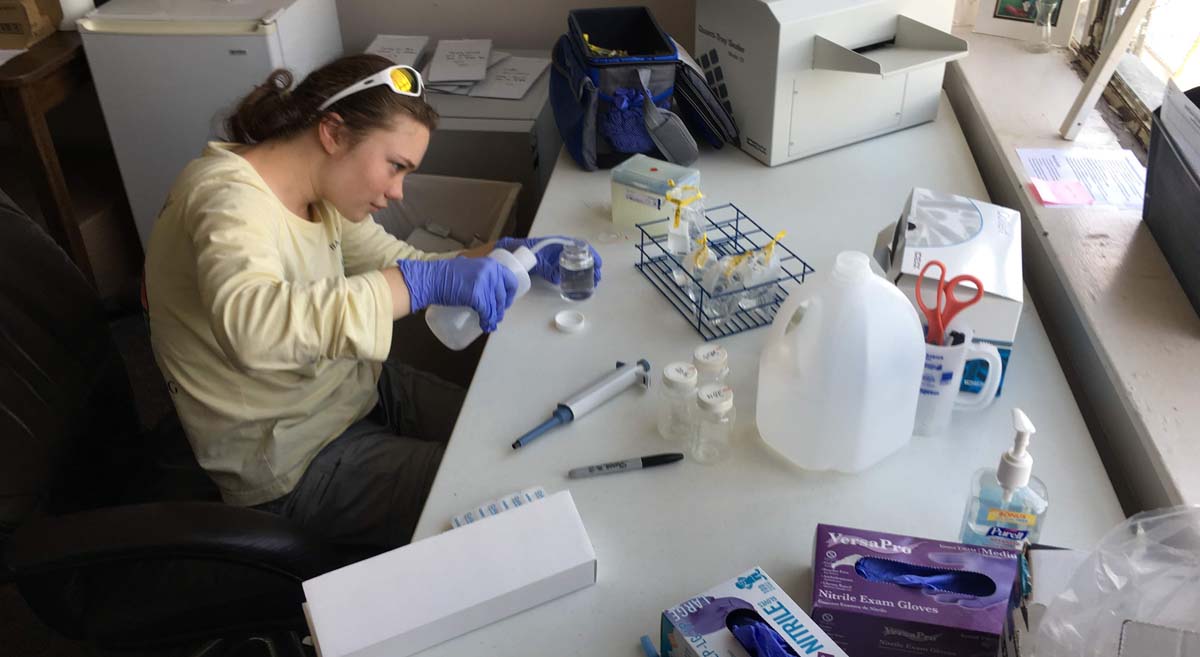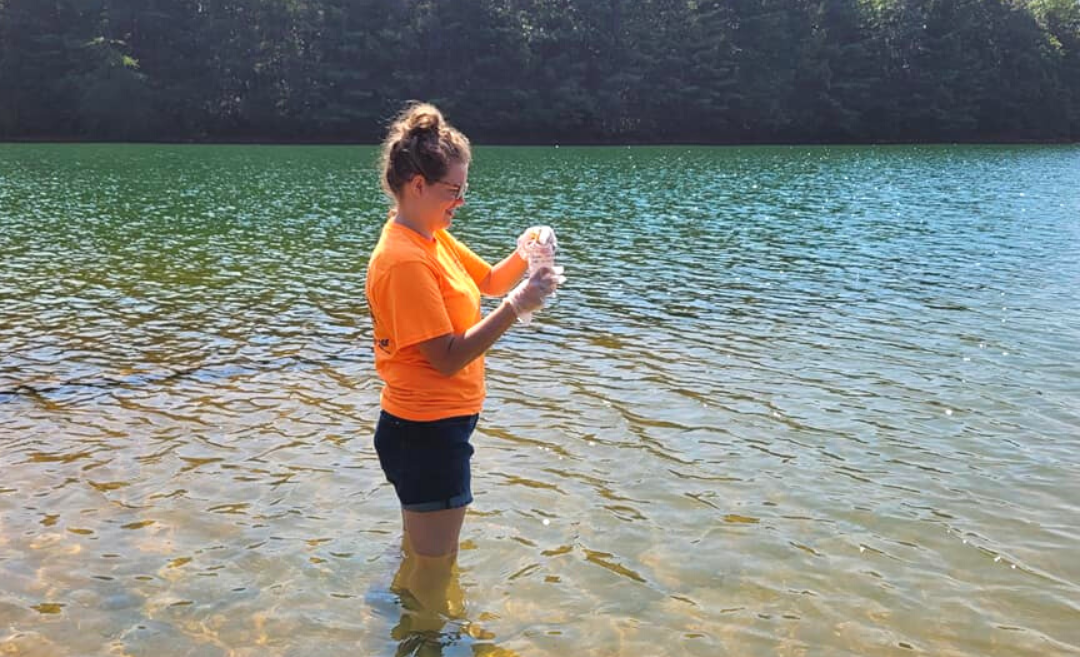Swim Guide Watershed Report: Hiwassee River Watershed

For the Hiwassee River Watershed, the 2021 water quality testing season gave rise to laudable successes. It also illuminated the need for deliberate action in areas of most concern. We’ll start with the good news, including which water testing sites had the lowest bacteria counts across the watershed. Then, we’ll give you the year’s bad news by spotlighting sites with the highest bacteria counts. We’ll conclude with achievable solutions for the future and a call to action so you can continue to help us protect the places we share.
Before we dive into our water quality summary, let’s review important terminology to help us better understand the data our Clean Waters team worked so hard to collect, analyze, and report. Cfu, or colony forming unit, is a metric scientists use to estimate the number of microbes present per 100 milliliters of a singular water sample. Microbes (also known as microorganisms) include bacteria, algae, and fungi. Like most things, some microbes are good for human health and some aren’t. We test for E. coli bacteria because it’s the best indicator for the presence of microbes that pose threats to human health.
According to the US Environmental Protection Agency (EPA), 235 cfu/100mL is the safe standard for primary recreational waters, where people are most likely to engage in recreational activities involving underwater immersion and potential water ingestion.
Good news headline: Lakes Largely Free of E. Coli and Other Pathogens
Twenty twenty-one has been kind to Hiwassee Lake, Lake Chatuge, and Late Nottely. Sites on these three lakes produced a total of 11 readings with zero E. coli or other pathogens. Hiwassee Lake at Hanging Dog secured this year’s prize for best site with an average E. coli count of 6.5 cfu/100mL.

About Our Swim Guide Program
Swim Guide is an international program used by Riverkeepers and other advocates to provide up-to-date recreational E. coli data for beaches, lakes, and rivers worldwide. E. coli is a bacteria found in the fecal waste of warm-blooded animals, including humans, and indicates contamination in our waterways. E. coli levels increase with rainfall events due to surface runoff and sewer overflow events.
Samples are collected every Wednesday from Memorial Day to Labor Day. Volunteers collect surface water samples in a 100mL sample bottle and drop samples off at the lab, to be processed by MountainTrue staff. Results from samples are measured in MPN, the most probable number of colony-forming units (cfu). The EPA’s limit for recreational water quality is 235 cfu/100mL. The EPA estimates at that concentration, 8 in 1,000 people will contract an illness.
Pass/Fail results are updated every Friday on www.swimguide.org to inform the public about local water quality. We use the data generated from our Swim Guide Program to identify sites for follow-up sampling. We sample in both urban and rural areas. Determining the location and source of E. coli in our waterways is one way we can solve pollution problems.
Bacteria levels in Lake Chatuge’s swimming beaches at Jackrabbit Mountain and in Towns County, Georgia, were commendably low. With an average E. coli count of 25.4 cfu/100mL, Lake Nottely’s Poteete Creek Park swimming beach also passed the EPA’s 235 cfu/100mL safe primary recreation standard with flying colors. Additionally, Clay County’s Fires Creek proved to be in good condition.
While not as clean as Hiwassee Lake or Lake Chatuge, samples taken from Lake Nottely and along the Nottely River showcase the relatively clean quality of these western waters. We collected our water quality samples during the 15 weeks between Memorial Day and Labor Day. Fortunately, our testing site at Nottely Dam failed to pass the EPA’s safe primary recreation standard only once.
Bad news headline: Heavy Rains, Leaky Septic Systems, and Animal Agriculture are Culprits of Hiwassee River Watershed’s Bacteria Pollution
Our Valley River site at Konehete Park rushed into 2021’s top worst spot with an E. coli count of 914 cfu/100mL, failing to pass the EPA’s safe primary recreation standard 80% of the time. Years of continued bacteria pollution have sadly caused the lower end of the Valley River to remain on North Carolina’s List of Impaired and Threatened Waters.
Poor animal agricultural practices, domesticated Canada Goose populations, and leaky septic systems are the primary causes of pollution in the Valley River. Monthly testing conducted upstream in both Andrews and Marble indicate that the Valley River’s E. coli problem is presently contained in the lower third of the river system.
Similarly, animal agriculture in the Sweetwater Creek Watershed is likely a primary contributor to the Hiwassee River’s larger E. coli pollution problem. One of our worst testing sites along the Hiwassee River, Sweetwater Park’s average E. coli count of 396 cfu/100mL failed to pass the EPA’s safe primary recreation standard 40% of the time. Monthly testing conducted upstream and downstream of Sweetwater Park suggests the bacteria pollution is currently isolated in a small portion of the Hiwassee River, including the confluence of Sweetwater Creek.
Another one of our worst sites of 2021, Meeks Park II canoe/kayak launch on the Nottely River produced an average E. coli count of 342 cfu/100mL and failed to pass the EPA’s safe primary recreation standard 53% of the time.
The week of September 1 proved to be the summer’s worst, with the aftermath of Hurricane Ida wreaking havoc across much of the Southeast. On average, the Hiwassee River Watershed received four inches of rain in the 48 hours before that week’s samples were taken. Ida’s increased rainfall caused the average E. coli count across each of our 10 water quality testing sites to spike at 371 cfu/100mL.
The weeks of August 11 and 18 also saw portions of the Hiwassee River Watershed receive several inches of rainfall shortly before our samples were taken. Hurricane Fred’s surge of stormwater in mid-August resulted in the highest overall E. coli levels of the summer at seven of our testing sites.
Future news headline: Mitigating Threats Posed to Hiwassee River Watershed by Pollution
The Hiwassee River Watershed is relatively clean. Still, we must be wary of negative changes associated with future summer seasons’ heavy rains. Polluted stormwater runoff remains a formidable threat to the Hiwassee River Watershed and the whole of the Southern Blue Ridge.
Water quality will suffer as higher annual amounts of stormwater runoff enter local waters due to climate change. Poor animal agriculture practices, outdated stormwater infrastructure, and decrepit septic systems will lead to future declines in water quality. That’s why we need to take action to address climate change — a pressing issue that affects us all.
MountainTrue is currently working with our state legislators to reinstate the Waste Discharge Elimination (WaDE) program, which is focused on identifying and fixing impaired septic systems. We also aim to secure increased funding for County Soil and Water Conservation Districts through our work with the North Carolina State Legislature. This necessary funding would help farmers adopt additional best management practices, like fencing livestock out of waterways and installing stream buffers to mitigate bacteria-laden runoff.
We believe these solutions will significantly improve the Valley River’s water quality and positively impact other Hiwassee River Watershed sections.
Moving forward, MountainTrue will:
- Encourage government officials to implement policies addressing land use and development impacts and make worthy investments to improve existing stormwater and septic system infrastructure.
- Continue to monitor sites of most concern while aiming to pinpoint and eliminate sources of E. coli pollution at our newest testing sites in the near future.
- Further develop valued relationships with community members and our local Soil and Water Conservation Districts to minimize threats posed to water quality by poor animal agriculture practices.
Want to learn more about our efforts to bring about clean water for all? Check out our ILoveRivers webpage and join MountainTrue’s dedicated community of volunteers to help us protect the places we share.

